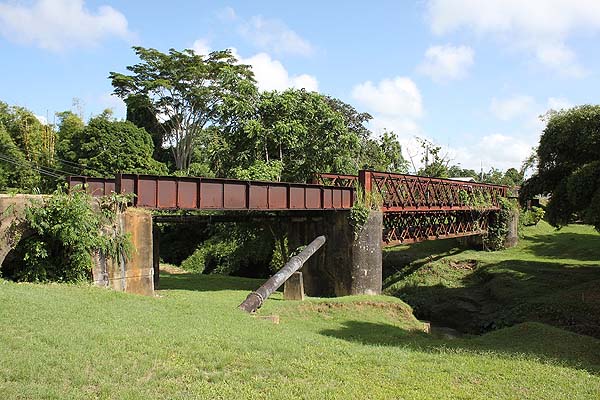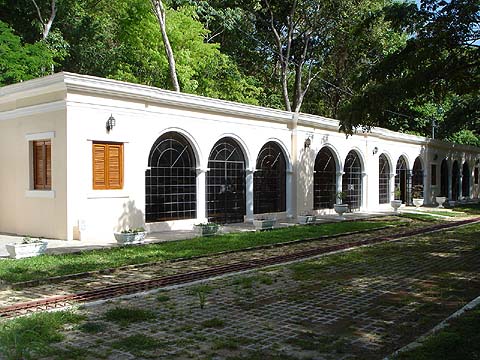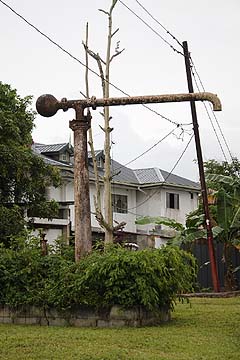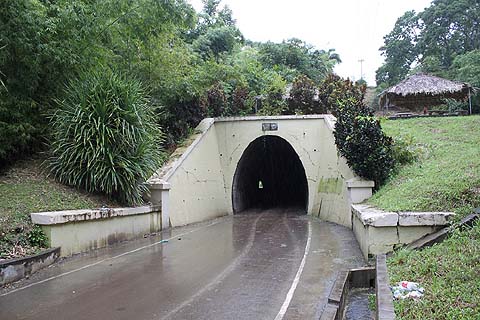|
Thomas Kautzor has been to several Caribbean islands to check out what is left
of their railways and industrial heritage.
For the full general index, see Railway Relics (and more) in the Caribbean,
He reports on his visit with Torsten Schneider to Trinidad, 4th - 5th September 2014.
See also:
Together with Torsten Schneider, I spent two full days in Trinidad looking for railway remains. ‘Trinidad Railway Expert’ Glen Beadon had arranged for his friend and ‘Trinidad Railway Photographer’ Wayne Abraham to show us around. We intended to see all of the surviving locomotives on the island, as well as a good sample of other railway remains, such as station buildings, bridges, signal boxes, etc… and were very successful in achieving that goal. It should be noted that there are a huge number of small remains (bridges, building foundations, poles, platforms) associated with the railway along the old railway lines, but unless you are told by an expert where and for what to look, these would mostly be overlooked. Even most residents of the island would not know that these would have been associated with the railway. It must also be said that many of these items are being lost every year to construction, scrap thieves or general decay.
In the past, Trinidad had a standard gauge government railway, a number of plantation railways serving various sugar factories which used both standard and narrow gauge track of 30 inch, 36 inch and 42 inch, as well as a few narrow gauge refinery railways. Today, only one short narrow gauge industrial railway is still in use.
The capital of Port-of-Spain also had a tramway system. The first line was a 42 inch gauge mule tram opened in 1883. In 1895 the Belmont Tramway Co. opened the West Indies’ first electric-powered railway system. In 1902/03 all the private lines were taken over by the Trinidad Electric Light & power Co., converted to standard gauge and electrified. The tramway system closed in 1950.
The smaller island of Tobago is not known to have ever had any railways.
Sources:
- W. Rodney Long, “Railways of Central America and the West Indies”, Washington, DC: U.S. Bureau of Foreign and Domestic Commerce, 1925 (pp. 360-370);
- Roger R. Darsley, “Caribbean Cane Tramways – 2 Trinidad”, in International Railway Record No. 113 (June 1988), pp. 248-263;
- David Rollinson, “Railways of the Caribbean”, Oxford: MacMillan Caribbean, 2001 (pp. 92-97, 119-120);
- Robin Barnes, “Eastern Region to West Indies”, in Locomotives International No. 61 (February-March 2002), pp. 26-27;
- Roger Darsley, “Sugar Cane Railways in Trinidad”, in NTSRA Newsletter, Summer 2005, pp. 12-19;
- “Trinidad Government Railways”, in Continental Railway Journal No. 170 (Summer 2012), pp. 513-515 (incl. TGR steam & diesel locomotive list);
- Wayne Abraham, “Trinidad Railway History (A brief account: key dates and some items of interest)”.
Trinidad Government Railway (TGR):
The first line between Port-of-Spain and Arima, the center of the island’s expanding cocoa industry, a distance of 15.5 miles, was opened on August 30, 1876. This was however not the island’s first railway, as in 1859 the Cipero Tramway, an agricultural line from the Cipero Wharf in San Fernando to Usine Sainte Madeleine sugar factory was completed. The tramway used mules as motive power. In 1861 the line was extended east to the town of Mission (later renamed Princes Town). In 1864 the first steam locomotive, “Forerunner”, was introduced.
Between 1880 and 1914 the TGR was gradually extended, and the Cipero Tramway acquired in 1913. At its largest extent, total mileage of the railway system including sidings and loops was 150, of which 115 were worked by TGR and the remainder leased, consisting of the following lines and branches:
- Port-of-Spain – San Juan – St. Joseph – Curepe Jn. –Tunapuna – Tacarigua – Arouca – Dabadie – Arima (opened 1876) – Guanapo (1896) – Cumuto – Guaico – Sangre Grande (1897);
- Curepe Jn. – Caroni – Cunupia – Jernigham Jn. – Chaguanas – Carapichaima – Couva (1880) – California – Claxton Bay – Pointe-a-Pierre – Marabella Jcn. – San Fernando (1882) – Corinth – Debe – Penal – Siparia (1913/14);
- Jerningham Jn. – Longdenville – Todds Road – Caparo – Brasso Piedra – Flanagin Town – Brasso Caparo – Tabaquite (1898) – Brothers Road – San Pedro – Rio Claro (1914, Caparo Valley Line);
- Marabella Jcn. – Union – Reform – Williamsville – Princes Town (Guaracara line, 1884);
- San Fernando – Corinth – Sainte Madeleine – Jordan Hill Jcn. – Princess Town (ex-Cipero Tramway);
- Jordan Hill Jcn. – Bronte.
Between Port-of-Spain and Curepe Jn., the line was double-tracked in 1923/24.
Much of the TGR lines were planned to pass through fertile agricultural land. At various points, the plantation railways of the following sugar factories connected with the TGR lines: Caroni, Woodford Lodge (near Chaguanas), Waterloo, Brechin Castle (near Couva), Usine Sainte Madeleine and
Oropouche.
While traffic grew with the development of the oil industry and World War II, increased competition from road transport brought an eventual post-war decrease in traffic and an increased need for government subsidies for the railway. The demise of the TGR started in 1953, with the closures of the Siparia line and the Sangre Grande extension. In 1963, the Madory Report recommended the closing of the railway in favor of road transport, a recommendation which was adopted by the authorities at the time, a big mistake in retrospect in view of the present traffic situation on the island’s roads. In 1964, the Siparia line was reopened temporarily to accommodate school children, but the following year the San Fernando, Rio Claro and Siparia lines were shut down permanently, leaving only the line from Port-of-Spain to Arima open to traffic. Finally, on Saturday December 28th, 1968, the last scheduled passenger train operated from San Juan to Port-of-Spain, hauled by TGR 2-8-0 No. 42.
Since then, the TGR right-of-way between Port-of-Spain and Arima (12 miles) has been turned into the PBR priority busway and Port-of-Spain station turned into the City Gate bus station.
The building was designed by German architect David Hahn and completed in 1924, to replace the original wooden structure. Today it is managed by and houses the headquarters of TGR’s successor, the Public Transport Service Corporation (PTSC), which operates bus services all over the island. The PBR is used by PTSC buses, private maxi-taxi shared taxis and during off-peak hours by HOV3 private vehicles. There are 10 stations and 46 other stops with laybys to permit passing. The former railway sheds and workshops at Port-of-Spain are nowadays used as a garage for the PTSC bus fleet.


Just across the street from the station building, TGR 0-6-0ST No. ‘D’ (HE 1168/1914) is on display in the yard of The Museum of the City of Port-of-Spain, which is housed in Fort San Andres (open Tu-Fr 9am-5pm). The loco is now (erroneously) numbered No. 42 in memory of the loco that hauled the last train from San Juan to Port-of-Spain, however No. 42 was MLW 69060/1937, a 56 tons 2-8-0 which was scrapped in 1973. No. D probably spent its working life shunting the Port-of-Spain docks and its livery was always black. Its sister loco No. E (HE 1169/1914) was scrapped sometime between 1952 and 1968.
For more on D check out Glen Beadon's article http://www.trinidadexpress.com/news/Real-story-of-Engine-D-285931141.html.


During construction of the PBR, most of the TGR structures along the line were demolished, however, at St. Joseph the station building still stands and is now in use as a private home and church.
On the line to San Fernando, not much except the platform is left at Caroni station (the smaller TGR station buildings were made of wood, so decayed quickly after closure), however just north of it the steel bridge across the Caroni River survives, while south of it, the Railway Bar faces the former Southern Main Road level crossing. Inside, the brass number plate of TGR 4-4-0T No. 11, which is plinthed in San Fernando, is on display above the bar and a number of black-and-white pictures of the TGR hang on the walls.

Further south towards San Fernando, between Couva and Brechin Castle sugar factory, a large three-span steel brudge across the Couva River survives.

Pointe-a-Pierre station is now on the grounds of the Petrotrin refinery. The station building has been extended and today houses the Petroleum and Asphalt History Museum, opened in 07/2009 and managed by the Petroleum Historical Society.
Outside displays include a Ruston & Hornsby portable steam engine (minus its front axle) and a stationary steam engine. However, due to a lack of funding and shortage of staff, the museum has closed and we found the gates locked,
so these are Glen Beadon's pictures from 2009.
In San Fernando, the ruins of the 1903 masonry station building which replaced the original wooden structure as well as a water
crane still survive at King’s Wharf not far from the bus station:
Up in town on Harris Promenade, TGR 4-4-0T No. 11 (Kitson 3591 of 12/1894) has been on display since 1967, nowadays behind a fence (2 pics). Shortly after our visit, the Mayor of San Fernando ordered the locomotive restored and repainted, see
http://www.trinidadexpress.com/news/Preserving-historic-Engine-No-11-278189461.html.
TGR No. 11 was one of 18 4-4-0T built by Kitson and to one exception by Nasmyth Wilson (No. 16) between 1897 and 1907 which formed the mainstay of the TGR main line loco park until the arrival of more modern tender locos after WWI. A number however survived until closure on branch line service.


At Stanley Village, not far from Usine Sainte Madeleine, an original signal box, today somebody’s home, as well as a point lever built by Tyer & Co. of London & Carlisle still survive.
On the Rio Claro line, the water tank, platform (now the foundation for a bus shelter) and water
crane of Caparo station survive,
Just north of Tabaquite, Knolley’s Tunnel (1898) has been turned into a minor tourist attraction:
TGR Locomotive List (for more details, see CRJ 170 p. 515):
|
|
0-6-0T |
Hunslet |
1874 |
|
|
1-18 |
4-4-0T |
Kitson, Nasmyth Wilson |
1875-1907 |
|
|
19-20 |
4-4-0TT |
TGR Port-of-Spain |
1923 |
|
|
21-29 |
4-6-0 |
MLW |
1919/21 |
|
|
31-32 |
4-6-0 |
Armstrong Whitworth |
1928 |
|
|
41-43 |
2-8-0 |
MLW |
1937/42 |
|
|
51 |
0-8-0D |
Hunslet |
1940 |
|
|
52 |
Bo-Bo DE |
GE (45-ton) |
1944 |
1947 ex USATC 7439 |
|
53 |
Bo-Bo DE |
GE (44-ton) |
1942 |
1947 ex USATC 8579 |
|
54-55 |
Bo-Bo DE |
GE (44-ton) |
1954 |
|
|
56-60 |
Bo-Bo DE |
GE (44-ton) |
1945/47 |
1962 ex NYNH&H |
|
61-62 |
4-6-0 |
MLW |
1942 |
|
|
71 |
2-6-2 |
Baldwin |
|
1942 ex U.S.A. |
|
(72) |
4-4-0 |
|
|
1942 ex U.S.A. |
|
73 |
2-6-0 |
Alco |
|
1942 ex U.S.A. |
|
A-D |
0-4-0ST |
Hunslet |
1879/80 |
|
|
D”-E |
0-6-0ST |
Hunslet |
1914/15 |
|
|
F-H |
0-6-0ST |
MLW |
1919 |
|
During World War II, the U.S. Army brought in a dozen General Electric 44/45-ton diesel locos for construction of Waller Field under the land lease agreement. Two of these were sold to the TGR in 1947, the other returned to the U.S. In 1954, TGR bought an additional two new through Neal & Massey Engineering and in 1962 another five were bought used from the New York, New Haven & Hartford RR (No. 0815, 0807, 0810, 0811 and 0818). The diesels were however unable to cope with the rush-hour trains, so a few steam locos were retained until closure.
The TGR also experienced with railcars. In 1910 two London, Brighton & South Coast Railway steam railcars built in 1905 with engine portions manufactured by Beyer Peacock were acquired, but these did not last long. In 1931, Sentinel twin articulated steam railcar No. 1 was acquired. And in the 1960s, ex-British Railways diesel railcars E50415 and E50419 (Wickham 1957) with accompanying trailers E56170 and E56174 were obtained and lasted until closure.
One quarter of the coaching stock were bogie vehicles, the remainder and most of the freight wagons four-wheeled.
After closure in 12/1968, all of the equipment was sold to Caribbean Steel Mills Ltd. and scrapped by 1973.
Trinidad Rapid Railway Project (TRRP), “TriniTrain”:
Many people in Trinidad still regret the closure of the railways especially now that the roads are constantly gridlocked. In 2008, the government announced a project to build a two line rapid rail transit network in Trinidad, with the East-West line extending from Westmoorings (west of Port-of-Spain) to Sangre Grande (54 km) and the North-South line from the University of the West Indies in St. Augustine to San Fernando (50 km). A French consortium was selected, formed of Alstom, Bouygues Construction and RATP Développement. Construction was due to start in mid-2010.
Due to a change of government, the project was scrapped in September 2010. Since then, even though new roads are being built, the gridlock has become even worse.

|
|



























